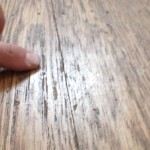Oct
Consequences of waiting too long for a refinish
The oak flooring that exists within the majority of the homes in most of the united states is plain sawn material. You can see within the following picture what is the difference between plain sawn flooring and quarter sawn wood flooring. The springwood and summerwood shown in the diagram vary in density. The springwood is softer and more vulnerable to wear.
If you look at the latter pictures I’m pointing to one section of the floor in particular that was next to the dining area of the house. You can see a considerable amount of damage or “grain dish-out” in the boards. This happened because the finish had been worn through for a number of years. Continued foot traffic across the floor ever so slightly digs the soft grain down farther and farther. The longer this happens, the more you need to sand the floor to create flatness again. This takes away the life of your floor when you have to sand so deep to remove the problem. In some cases I have seen the dish out is so bad that the boards needed to be replaced, adding to the cost of the project.
The other contributor to premature finish wear is improper floor cleaning by using water and vinegar. Vinegar (acetic acid) can eventually attack finish over time. Vinegar attacks the finish within the soft grain before the hard grain of oak in most cases I’ve seen over the years. Typically the best hardwood floor cleaners are pH neutral and low in residue.
Keeping everything in mind, I advise people to think about maintenance on their floors as more of a 3-5 year process through a buffing and re-coating with a new coat of finish. It’s not necessary to wait an eternity and undergo a full hardwood floor refinish. A recoat takes generally one day and is lower in cost. By lightly abrading the floor, you can remove surface (not really deep) scratches and restore the floor. The only caveat is that you must not have applied wax to your floor or the recoating process will be likely compromised.





